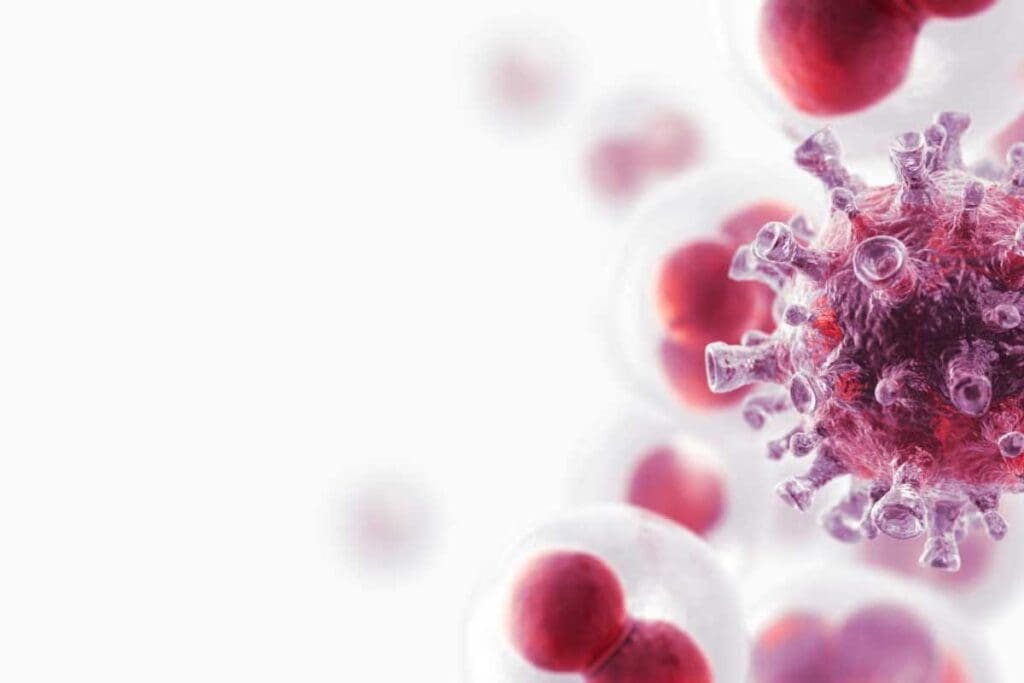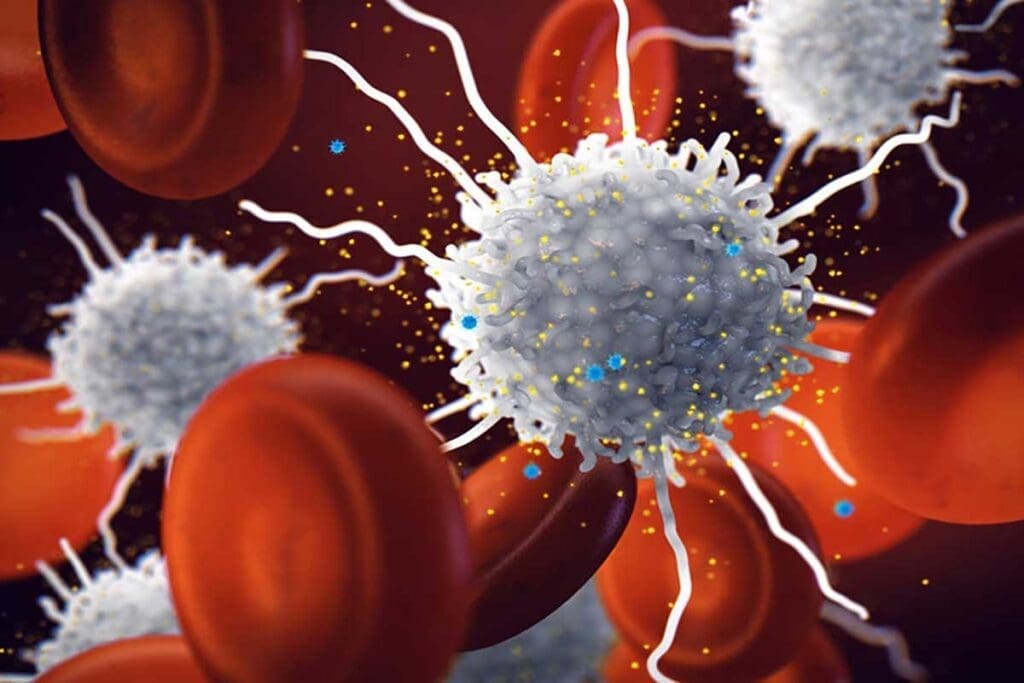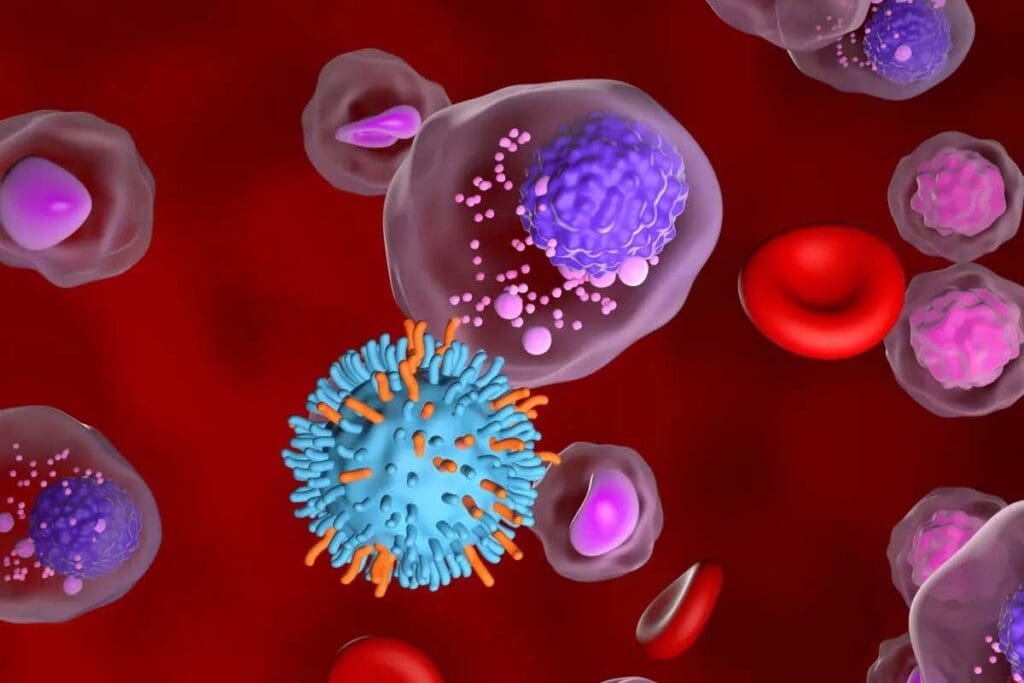Last Updated on November 20, 2025 by Ugurkan Demir

White blood cells (WBCs) are key to our immune system. They help fight infections and diseases. A normal WBC count is between 4,000 to 11,000 cells per microliter of blood. Cancer can change WBC counts in different ways, depending on the type and stage of the disease, as well as the treatment approach.
At Liv Hospital, we know how important it is to understand cancer and WBC count. Our team is dedicated to giving personalized care and the latest treatments. We aim to manage each case with excellence.

White blood cells are key to our immune system. They help fight off infections and diseases. These cells are made in the bone marrow and travel through the blood.
There are five main types of white blood cells, each with its own job:
A normal white blood cell count is between 4,500 and 11,000 cells per microliter of blood. But, this can change slightly based on the lab, age, sex, and other factors.
White blood cell counts can change throughout the day. This can be due to stress, exercise, or certain medicines.
Many things can cause white blood cell counts to change, including:
Knowing these factors helps us understand white blood cell count results better.

Cancer has a complex relationship with white blood cells. It can affect WBC production in different ways. This depends on the cancer type and its stage.
Cancer can directly or indirectly change WBC production. Some cancers, like leukemia, directly affect WBCs by making abnormal cells. Other cancers may indirectly change WBC counts through inflammation or bone marrow issues.
For example, leukemia directly impacts WBC production. It makes the bone marrow produce abnormal white blood cells. These abnormal cells can replace healthy cells, causing an increase in WBC count with dysfunctional cells.
Cancer can also cause inflammation, affecting WBC counts. When cancer develops, it can trigger inflammation in the body. This leads to an increase in white blood cell production.
The body’s immune system fights cancer by producing more white blood cells. While this is meant to protect, it can also cause WBC counts to rise.
Cancer can also impact WBC counts by affecting the bone marrow. When cancer spreads to the bone marrow, it can disrupt blood cell production. This can result in abnormal WBC counts, either high or low, depending on the extent of bone marrow involvement.
In summary, cancer’s effect on white blood cells is complex. It varies based on the cancer type, stage, and whether it has spread to the bone marrow. Understanding these effects is key to interpreting WBC counts in cancer patients.
Blood cancers like leukemia, lymphoma, and multiple myeloma affect WBC levels. They start in the bone marrow or lymphatic system. This can mess up how white blood cells are made.
Leukemia makes too many bad white blood cells in the bone marrow. This can raise WBC counts with lots of young or bad cells. The type of leukemia affects WBC levels differently.
For example, acute lymphoblastic leukemia (ALL) has lots of lymphoblasts. Chronic lymphocytic leukemia (CLL) has more mature lymphocytes. Knowing the leukemia type helps doctors understand WBC counts and plan treatment.
Lymphoma mainly hits the lymphatic system. It might not raise WBC counts like leukemia. But it can change WBC levels in its own way. For instance, Hodgkin lymphoma can increase lymphocytes.
Lymphoma cells in the bone marrow or lymph nodes can mess with normal white blood cell production. This can lead to odd WBC counts. The exact effect depends on the lymphoma type and how advanced it is.
Multiple myeloma is a cancer of plasma cells. It can mess with blood cell counts, including WBCs. It mainly affects plasma cells but can also impact WBC production by taking over the bone marrow.
People with multiple myeloma might see WBC count changes. This could be because of cancer cells in the bone marrow or treatment side effects. Keeping an eye on WBC levels is key in managing multiple myeloma and adjusting treatments.
Knowing how these cancers affect WBC levels helps us diagnose and treat them better. This can lead to better outcomes for patients.
Solid tumors can sometimes change WBC counts, but not always. These abnormal tissue masses can be benign or cancerous. The impact on WBC levels depends on the tumor’s type, size, and location. Also, if it has spread to other parts of the body.
Many solid tumors don’t affect WBC counts much. This is true if they are small and haven’t spread or damaged nearby tissues. For example, early-stage breast or prostate cancer might not change WBC production. Localized tumors usually don’t affect the body’s immune system much, so WBC counts stay normal.
But, if solid tumors spread to the bone marrow, they can mess with blood cell production. For instance, breast or lung cancer spreading to the bone marrow can change WBC counts. This might lead to leukocytosis (high WBC count) or leukopenia (low WBC count).
Solid tumors can also trigger inflammation in the body. This inflammation can raise WBC counts as the body tries to fight off the tumor. This response is caused by cytokines and chemokines that boost white blood cell production.
“The presence of a tumor can lead to a chronic inflammatory state, which in turn affects various physiological processes, including hematopoiesis.”
— Expert in Oncology
In summary, solid tumors might not always change WBC counts. But, their impact is big when they spread to the bone marrow or cause a lot of inflammation. It’s key to understand these effects to manage cancer patients and make sense of their blood tests.
Elevated WBC counts are common in cancer patients. They can mean different things depending on the situation. It’s important to look at the bigger picture to understand what they mean.
The meaning of a high WBC count varies with different cancers. For example, in blood cancers like leukemia, it often means the disease is active. But in solid tumors, it might show the body’s fight against the tumor or an infection.
When looking at WBC counts, we must consider the cancer type, its stage, and the patient’s health. For cancers like multiple myeloma or lymphoma, WBC changes are closely tied to the disease’s effect on blood cells.
An elevated WBC count can also signal cancer progression. This is worrying as it might mean the disease is getting worse or more aggressive. For example, a sudden increase in WBC count in a patient with stable counts could mean the cancer is advancing.
Watching how WBC counts change over time is key. It helps us see how the disease is moving and how well treatments are working.
While disease progression is a concern, it’s not the only reason for high WBC counts in cancer patients. Other factors include:
It’s vital to find out why a WBC count is high. We need to look at the patient’s overall health, medical history, and current treatments to understand the results.
It’s key to know how cancer treatments affect WBC counts to keep patients healthy. These treatments aim at fast-growing cancer cells. But, they can also harm fast-growing cells in the bone marrow, where white blood cells are made.
Chemotherapy is a common treatment that can weaken the bone marrow. This leads to low levels of neutrophils, a type of white blood cell. Neutropenia raises the risk of infections, which can be deadly. We watch WBC counts closely during chemotherapy to adjust treatment plans.
Radiation therapy can also harm the bone marrow’s ability to make white blood cells. This is more likely when treating large areas or when the radiation hits a lot of bone marrow. The impact on WBC counts varies based on the dose and area treated. We plan radiation therapy carefully to lessen its impact on the bone marrow.
Targeted therapies and immunotherapies are newer cancer treatments. They can affect WBC counts differently. Some may raise or lower WBCs, depending on how they work. Immunotherapies, which boost the immune system against cancer, can sometimes increase WBC counts.
Steroids are used during cancer treatment to reduce inflammation and manage side effects. They can raise WBC counts by releasing more white blood cells into the blood. But, this effect is short-lived and can hide infections.
Supportive medications help manage side effects of cancer treatment, including WBC counts. These drugs support patients through cancer therapy challenges. They help reduce bad effects and improve outcomes.
Growth factors, like Granulocyte-Colony Stimulating Factor (G-CSF), boost white blood cell production. They are used during chemotherapy. G-CSF lowers the risk of neutropenia, a condition with low neutrophils.
Neulasta and Neupogen are G-CSF drugs for cancer patients. They increase neutrophil production. This reduces infection risk and lets patients keep up with treatment.
| G-CSF Medication | Primary Use | Effect on WBC Count |
| Neulasta (Pegfilgrastim) | Prevention of neutropenia during chemotherapy | Increases neutrophil production |
| Neupogen (Filgrastim) | Prevention and treatment of neutropenia | Stimulates neutrophil production |
Corticosteroids are used in cancer care. They are mainly for reducing inflammation and suppressing the immune system. But, they can also raise WBC counts, including neutrophils.
It’s important to remember that corticosteroids increase WBC counts. But, they also weaken the immune system. This can be complex for cancer patients.
Antibiotics treat infections in cancer patients, often due to low WBC counts. They don’t directly change WBC counts. But, they are key in fighting infections caused by low counts.
Other treatments include antifungal and antiviral drugs. These are for preventing or treating infections in patients with weakened immune systems.
In conclusion, supportive medications are vital in managing cancer treatment side effects. They can greatly affect WBC counts. Understanding these effects is key for healthcare providers to make the best care decisions.
The link between cancer and white blood cell count is complex. An elevated count is not always present. Cancer can take many forms, and its effect on WBC count varies. This depends on the cancer type, its stage, and the person’s health.
Some cancers may not raise WBC counts, at least not in the early stages. For example, certain solid tumors like breast or prostate cancer might not affect WBC production unless they spread to the bone marrow. We will explore this further in the following table.
| Type of Cancer | Likelihood of Affecting WBC Count | Typical Stage of Impact |
| Breast Cancer | Low | Advanced/Metastatic |
| Prostate Cancer | Low | Advanced/Metastatic |
| Leukemia | High | Early/Diagnosis |
| Lymphoma | Moderate to High | Varies |
Using WBC count alone for cancer screening is not reliable. Many cancers, in their early stages, do not change WBC levels. Other diagnostic tools and markers are more accurate for detecting cancer.
Limitations of WBC Count in Cancer Screening:
While WBC count is not reliable on its own, other blood markers are more specific to certain cancers. For example, Prostate-Specific Antigen (PSA) for prostate cancer, CA-125 for ovarian cancer, and Carcinoembryonic Antigen (CEA) for colorectal cancer.
Understanding these markers and their relevance to different cancers can aid in early detection and diagnosis. It’s important to consult healthcare professionals for proper interpretation of these markers and to determine the appropriate diagnostic pathway.
Cancer treatment needs regular checks on white blood cell counts. These cells are key to our immune system. Their levels can greatly affect how we handle cancer treatments.
Blood tests are done often to watch WBC counts. How often depends on the cancer type, treatment, and the patient’s health.
Typically, blood tests are performed:
| Treatment Type | Typical Blood Test Frequency |
| Chemotherapy | Before each cycle (usually every 3-4 weeks) |
| Radiation Therapy | Weekly or biweekly, depending on dosage and area treated |
| Targeted Therapy/Immunotherapy | Varies; often more frequent initially, then less often |
If WBC counts drop too low (neutropenia), or rise too high, action is needed. For neutropenia, growth factors like G-CSF (Neulasta, Neupogen) help make more WBCs.
For high WBC counts, treatment might include:
WBC count changes can show how well cancer treatment is working. For example, a drop in WBC count after chemotherapy might mean the treatment is effective.
But, it’s important to look at WBC counts with other tests and doctor’s assessments.
It’s important to know the warning signs of abnormal WBC counts. Both low and high counts can mean health risks. We need to act fast and get the right help.
A low WBC count, or leukopenia, makes us more likely to get sick. Look out for these signs that could mean something serious:
An elevated WBC count can mean your body is fighting something. Watch for these symptoms:
Talking to your healthcare team about your blood test results is key. Here’s what to do:
Being proactive and informed helps us work with our healthcare team. Together, we can manage abnormal WBC counts and find the cause quickly.
Monitoring white blood cell (WBC) counts is key in managing cancer. It shows how the body reacts to cancer and its treatment. Different cancers, like leukemia and lymphoma, can change WBC production, leading to abnormal counts.
Cancer treatments, such as chemotherapy and radiation, can also impact WBC counts. This makes regular monitoring very important.
The importance of WBC monitoring in cancer care is huge. It helps healthcare providers spot issues early, like infections or disease growth. They can then act quickly.
In summary, WBC monitoring is essential in cancer care. It helps doctors make better decisions about treatment and patient care. Understanding WBC counts helps us better handle cancer treatment and improve patient results.
Cancer can change white blood cell count, but it depends on the cancer type. Blood cancers like leukemia and lymphoma often raise WBC counts. Solid tumors might cause WBC counts to go up and down due to inflammation or bone marrow involvement.
Some cancers, like blood cancers, can raise white blood cell counts. But not all cancers do this, and other things like infections or inflammation can also increase WBC counts.
Yes, many cancers, including some solid tumors, might not raise WBC counts. It’s not safe to only use WBC count to check for cancer.
Treatments like chemotherapy and radiation can lower WBC counts, leading to neutropenia. Targeted therapies and steroids can have different effects, sometimes raising WBC counts.
Keeping an eye on WBC counts during treatment is key. It helps spot infection risks, adjust treatment plans, and see if WBC-related issues are being managed.
See a doctor if you have symptoms like fever, infections, or unusual tiredness. Talk about your blood test results with your healthcare provider.
White blood cell counts can be high in some cancers, like blood cancers. But the link between cancer and WBC count is complex. It depends on the cancer type and stage.
In some cases, like blood cancers, the WBC count can go up. But how cancer affects WBC count varies. Some cancers might not change WBC levels much.
An elevated WBC count in cancer patients might mean the disease is getting worse, there’s an infection, or inflammation. The exact meaning depends on the cancer type, treatment, and other health factors.
No, WBC count alone is not a good tool for cancer screening. It’s not specific enough and can be affected by many factors.
Subscribe to our e-newsletter to stay informed about the latest innovations in the world of health and exclusive offers!